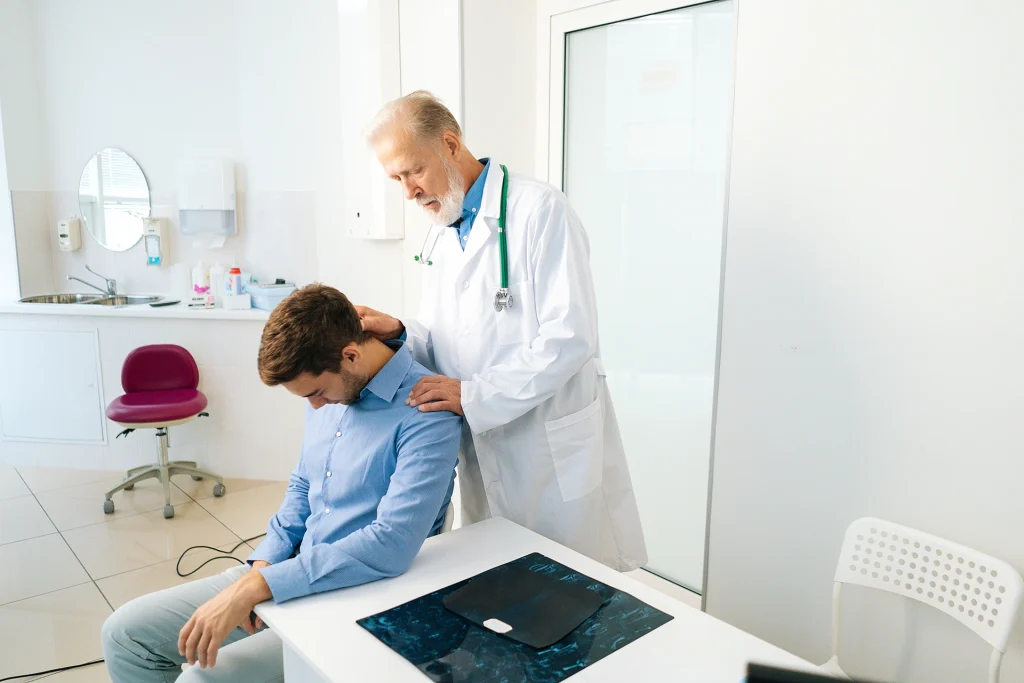Have you ever woken up with a stiff, sore neck that hurts more on the right side? Or maybe you’ve noticed pain and tension building up in your right shoulder and neck after long hours working at a computer?
Right sided neck pain is common, and can stem from various underlying issues. Getting to the root cause is key to finding the right treatment and prevention.
What Causes Neck Pain on The Right Side?
The neck is a complex structure, with muscles, joints, discs, nerves and vertebrae that all work together to support the head and enable movement. Disruptions to any of these structures can lead to pain. Here are some of the most common culprits behind neck pain on the right side:
Muscle Strains and Sprains
The muscles running down the right side of the neck are continually supporting and moving the head throughout the day. With poor posture or awkward positions, these muscles can become overworked, tired, and develop trigger points. Muscle strains or sprains in the neck are commonly caused by:
- Sleeping in an abnormal position that strains the neck. Many people sleep on their right side, twisting the neck awkwardly on the pillow.
- Cradling a phone on the right shoulder for prolonged periods. This strains the neck muscles as they work to keep the head from tilting.
- Reaching or turning the head to the right repeatedly. This overstretches the muscles on that side.
- Whiplash injuries, often from car accidents, that violently jerk the head to the right.
- Flying a kite or other activities with repetitive neck motion to the right.
When neck muscles are overworked, they develop micro-tears and become inflamed. This causes localized pain and tenderness, especially with movement.
Pinched Nerve or Radiculopathy
A common cause of right sided neck pain that radiates into the shoulder and arm is a pinched or compressed nerve in the cervical spine. This is known as cervical radiculopathy. It occurs when:
- A herniated disc in the neck pushes into the adjacent nerve root.
- Bone spurs form on the vertebrae due to arthritis, narrowing the spaces where nerves exit.
- An injury dislocates a cervical joint, pinching the nerve.
Pinched nerves cause sharp, shooting nerve pain down the arm, as well as numbness or tingling. There may also be muscle weakness on that side.
Arthritis in the Cervical Spine
As we age, wear and tear can cause the cervical discs to degenerate and the joints to become inflamed. Bone spurs called osteophytes may form.
This cervical spondylosis and spinal stenosis causes neck pain that is often worse on the right side in right-handed people who put more stress on that side. The pain may worsen with movement and feel better with rest.
Recognizing Symptoms of Neck Pain on the Right Side
Some of the characteristic symptoms that point to an issue with the right side of the neck include:
- Pain and stiffness localized in the right posterior neck. This may feel worse with movement.
- Aching, numbness or tingling that radiates from the neck down the right shoulder and arm. This indicates a possible pinched nerve.
- Reduced range of motion when turning or tilting the head to the right.
- Headaches concentrated on the right side of the head.
- Clicking, crunching or grinding sounds from the neck joints when moving.
- Muscle spasms and cramping in the right shoulder and neck area.
- Pain or numbness that shoots down from the neck into the arm and fingers.
Any neck pain that is severe, persistent, or accompanied by neurological symptoms warrants medical evaluation. Seek prompt attention for:
- Loss of bladder or bowel control
- Numbness, weakness or difficulty using the right arm or leg
- Dizziness, vertigo, loss of balance
- Unexplained weight loss along with neck pain
Getting a Diagnosis for Your Neck Pain

To pinpoint the underlying cause of right sided neck pain, your physician will begin with a detailed history and physical exam. They will ask questions about symptoms, onset, relieving or aggravating factors, and your health history.
During the physical, your doctor will palpate the neck and shoulder area to spot points of tenderness. They’ll assess the range of motion in your neck by having you move and turn your head in different directions. Neurological tests will check strength, reflexes and sensations in your arms and hands.
If a pinched nerve is suspected, your doctor may order electrical tests to measure how your nerves are functioning. Imaging tests may include:
- X-ray to evaluate bone structures and check for fractures or arthritis.
- MRI scan to look at soft tissues including discs, muscles and nerves.
- CT scan provides a more detailed bony view of the spine.
Once any pinched nerves or other issues are identified through testing, an appropriate treatment plan can be formed.
Effective Treatments Options for Neck Pain on the Right Side
The right treatment approach depends on the diagnosed cause of your neck pain. Here are some of the most common options for managing right sided neck pain:
Medications
Over-the-counter non-steroidal anti-inflammatory drugs (NSAIDs) like ibuprofen can relieve muscle soreness and arthritis pain. For severe nerve pain, opioid medications or muscle relaxers may be prescribed. Topical menthol gels or lidocaine patches can provide localized pain relief.
Physical Therapy
Physical therapists can provide treatments to reduce neck pain, improve range of motion, and correct posture issues. This may include:
- Gentle stretching and exercises specifically targeting the right side.
- Joint mobilization or soft tissue massage to relieve muscle tightness.
- Cervical traction to take pressure off pinched nerves.
- Ultrasound, heat or cold therapy to relax tissues.
- TENS unit electrical stimulation for pain relief.
- Postural and ergonomic advice.
Chiropractic Care
Chiropractors manipulate and adjust the neck joints to improve mobility and alignment. This can relieve pinched nerves, muscle tension, and headache pain stemming from the neck.
Steroid Injections
Injecting corticosteroid medication into inflamed cervical joints or discs can reduce swelling and irritation. This helps calm pinched nerves, arthritis, and disc herniations.
Surgery
If conservative treatments fail and there is serious nerve compression or spinal instability, surgery may be warranted. Options range from minimally invasive outpatient procedures to spinal fusion.
Right Side Neck Pain Relief at Home
In addition to professional medical treatment, there are many things you can start doing at home to manage and prevent recurrence of right sided neck pain:
- Improve posture when sitting at a desk or using mobile devices to avoid neck strain.
- Do neck stretches and exercises to strengthen the muscles. Try chin tucks, shoulder shrugs, and gentle neck rotations to the left.
- Use ergonomic furniture and equipment like supportive chairs and height-adjustable workstations.
- Limit activities that over-twist the neck such as golf, tennis and racquet sports.
- Apply ice packs to relieve acute muscle soreness or warm compresses to relax tense muscles.
- Consider an adjustable cervical pillow that aligns the neck and relieves pressure points during sleep.
- Get therapeutic massages to loosen up tight neck muscles causing asymmetry.
- Try relaxation techniques like yoga, meditation and breathing exercises to reduce muscle tension caused by stress.
- Maintain good health through nutrition and regular exercise to keep neck muscles flexible.
What exercises help relieve neck pain on the right side?
There are some simple neck exercises that can provide relief for right sided neck pain:
| Name of Exercise | Description | How to Do It |
| Neck Stretch to Left | Stretches the right side of the neck | Slowly tilt head to the left, feeling a stretch on the right side of neck. Hold for 10-15 seconds. |
| Shoulder Rolls | Relaxes shoulder and neck muscles | Roll shoulders up and back in a circular motion 5-10 times. |
| Isometric Neck Turn Left | Strengthens the right side of the neck | Place hand on left side of head and gently push head against hand while turning to the left. |
| Chin Tucks | Stretches the cervical spine | Bring chin straight back, holding for 5-10 seconds. Feel a stretch in the back of the neck. |
| Neck Rotation Left | Stretches the right side of the neck | Turn head slowly to the left as far as comfortably possible. Hold for 10-15 seconds. |
Finding Relief for Neck Pain on the Right Side

As we’ve explored, neck pain localized on the right side can stem from various causes including muscle strains, pinched nerves, poor posture, arthritis, and injuries.
While symptoms may arise on the right side, successfully treating and preventing recurring pain relies on addressing the root issue through proper diagnosis, targeted treatment, and daily neck care.
For personalized guidance in managing stubborn neck pain on the right side, consider consulting online professionals like those at Kaly.
They can listen to your unique situation, answer questions, and suggest lifestyle changes, self-care tips, or exercises targeted to your symptoms. With an expert’s advice and your diligent efforts, relief for your right-side neck pain may be within reach.
